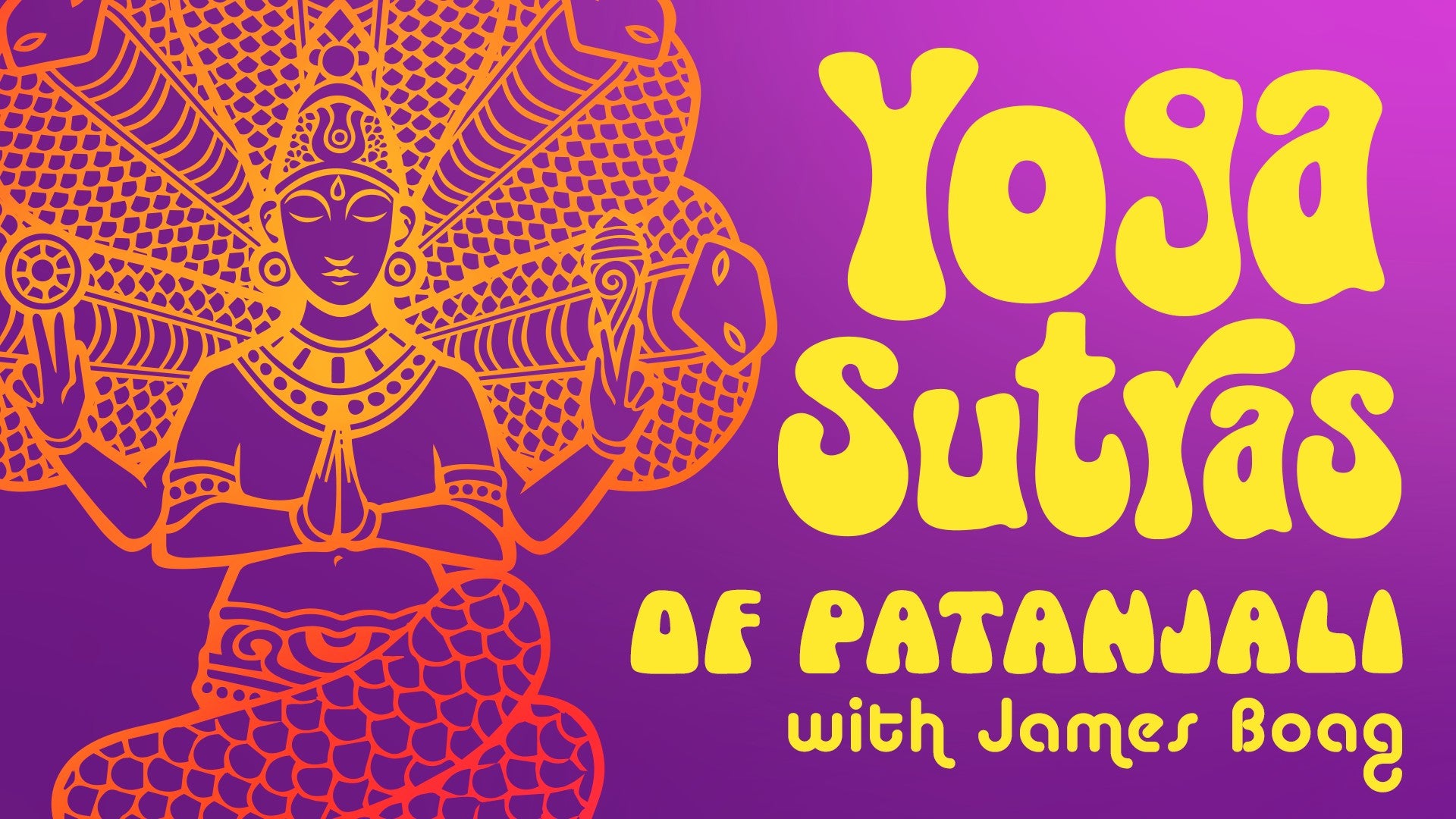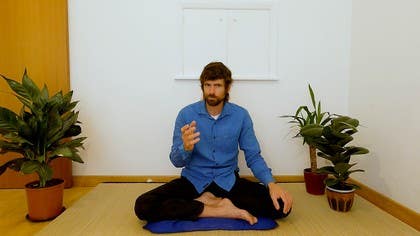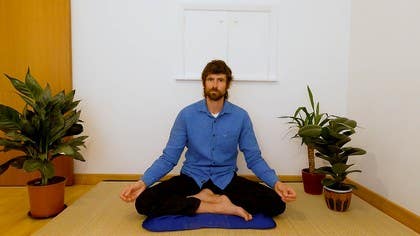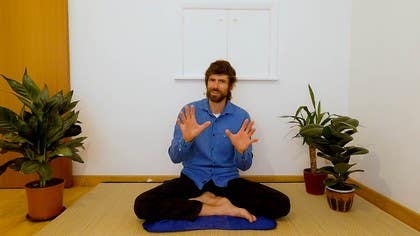Description
In sutra 2.32, shaucha santosha tapah svadhyaya ishvarapranidhana niyamah, Patanjali introduces the Niyamas: shaucha (cleanliness and purity of body and mind), santosha (an attitude of contentment), tapas (training of the senses), svadhyaya (self-study), and ishvarapranidhana (an attitude of surrender to God or Source). James explains that the Yamas and Niyamas are mutually supportive parts of the wheel of dharma, and that by putting them into regular practice we can fortify our connection to our internal intuitive wisdom.
Please see attached .PDFs to follow along with James.
About This Video
Transcript
Read Full Transcript
So now Sutra32 potentially just told us that the Yamas are the universal great vow to be observed at all times, in all places, in all situations, regardless of the fashion circumstance situation, they are the great vow. Some people also consider that the Niyama are really also kind of understood to be the subsequent part of that vow. Working with the Niyamas will also make it easier to observe that great vow. So Yamani Yamma 5 yammers, 5 near mes, we can consider them as mutually supportive parts of what I would call 1 wheel of Dottoman. So I'd like to show, first of all, The 5 Niyamas on the screens will bring up a visual of the 8 limbs again.
So at the bottom of the sheet, you can see the 5 Niyamas. So the sutra tells us what the Niyamas are. The Neamazar, Shocha, which means purity, cleanliness, Santoshka, contentment, and tapas Fadia Ishweta Praniddhana, We've already encountered those terms at the beginning of the chapter as these foundation principles, Tappaha, that steady illuminating fire of yogic and balanced discipline, Sfadiyai, self study inquiry into truth and the deeper reality of spirit of the mystery of life and Ishwila Pranidhan are concentrating our actions. So these are the 5 Niyamas. Now some of those people talk about these as observances.
Things we need to observe. People also talk about how the yamas we can see an emphasis on our relationship to others and Niam as it's really about relation to ourself. I don't really go along with that. For me, Yammer cultivating harmony and on non harming, that's just as much about marriage to to myself as it is to everybody and everything else. It's not just about external things. Similarly, the, Neumas, yeah, I observe cleanliness and purity, not just immoration to myself, but merge it to others.
So I reject that distinction and consider Yama and Niyama as things that I can constantly work with in all domains of life. That's why there's such a beautiful and powerful and practical lens. Now, one of my teachers also spoke about the yamaniyaman as spokes on a wheel of dharma. And so I'd like to share this image and illustration here. So first of all, What is a chakra dharma? What is a wheel of dharma?
The flag of India actually has a chakra dharma on it. So just to illustrate the general principle, we can see here a wheel with 8 spokes. And the teacher who first I heard this idea from, he used this example of a wheel with 8 spokes And he said that the 8th folks, they relate to the the the 5 sends powers plus Manas, buddi, and Ahankara. Those 3 constituents of our Anta Karuna, the internal instrument of awareness. And as it says on the diagram, when all of those are connected to our essence, are connected to our conscience, then that connection to conscience can become more and more robust.
So we can consider, this is one example of a dharma Chakra in this area that when all those eight spokes are well aligned when they're all serving conscience, when they're all being like, if a wheel is true, yeah, if all the spokes are true to conscience, then we're gonna roll along pathways and roads and by ways of life in a dodomic way in a way that supports our well-being and the well-being of the whole. We can also consider Yamah Niyama as a ten spoke wheel So there's another diagram that I'd like to show now, and this is the yamaniyama wheel of dharma. And here are 10 spokes one for each of the yamers and the new yamers. So each spoke is a means for us to tune in what is appropriate here. Now, sometimes we can experience, I'm in a situation where I feel torn, the classic yoga situation, like the beginning of the bhagavad Gita, origin of the student is on the battlefield.
He doesn't know what to do. And this is when yoga happens, or we need to actually reconcile things, bring ourselves back into balance. Now sometimes people can have the experience, and I've had this experience some, you know, many times, is this my conscience, or is this my tricky mind ego complex masquerading as the voice conscience. Am I reasoning myself out of my deep intuitive wisdom towards something that's actually protecting a status quo that is really self sabotage. Sometimes it's very easy.
To discern the voice of what is right, what is appropriate, what is the correct way forward. But sometimes we do feel tall. Sometimes it's not so clear. Now how do we discern? It's the idea that through practice, We can fortify our connection to conscience.
We can reclaim it. Often many layers of our conditionings they've created some distance, some interference with our connection, our tuning to that internal voice of conscience, to that connection to the deeper intuitive wisdom of cosmic intelligence that we are part of as well. So as we are going about that rehabilitation recovery project, there's this very practical helpful idea that the lens is the frames of reference of each of the Yemeni Yamans, we can consider them as these 10 spokes of the wheel. If I'm not sure about, is this the appropriate course of action? Well, I can check-in. Is it a Hintza?
Is it Satya? Is it Astellia? Is it from Macharia? Is it Aparigraha? For example, so is it cultivating harmony? Or is it being harmful? Is it authentic? If I'm fully present here, what which way do I feel is the appropriate action?
Is it respectful? Is it using my energy in a way that's gonna help energy grow and consolidate and become stronger, or is I'm gonna feel a lot of tension or wasting my energy here, Perigraha. Am I being bound by my expectations? Can I loosen my grip relaxed present for presence, for example? But remember, uhinsa is prime.
So the delineation of the Yamas, we want to make sure first Ahinsa and then Satya and then Astaya. So with a hint on Satya, classic example is sometimes you would say, well, is it ever okay to tell a lie? And there's the idea, well, if some falsehood is for the sake of some greater good Then it might be the case that we have to subordinate satya to, but what we're really aiming for is that that they all line up So the spokes of the wheel are all true to the center. So if we're in a situation where we feel, oh, well, that's ticking the Satya box, but it's not taking the the inside box, then maybe I need to consider again. Can I loosen my grip? Can I invite a new insight?
Can I stay committed to authentic darmic action? Without compromising my own integrity. That is the razor edge of practice. And there's that the yamaniyama wheel is a means to attune to that. Now, I'm aware. I just gave an example. I would not really want to give I don't want to sacrifice Satya for the sake of Ahintza.
What I want to illustrate by that example is the idea Ahinsa is the governing principle. All the other 9 Yamani Yamas are for the sake of Ahinsa. If we can become established in a Hinsa, say we can we'll become established in yoga. Nonetheless, they're each very robust lenses. And there's a curious thing, I would invite you to try this, especially if you can do it within groups or a companion, or some other people who are studying or exploring the overs, which are together, take ayama, and lets it be your focus for a week in your yoga practice, in the time you work with technique, and the rest of the day, And what many people report here is that when we do that, we notice that if, for example, in practicing a stair, I cannot really practice this day without practicing the other Yamas and Niyamas.
And so to work with the 10 yummy yamas in a 10 week cycle with a group, it's a fantastic thing to explore. So we've had the yamers and the yamers as the great vow and how to behave in the world. If that's how we would like to be, what to do if we feel inclined to a type of action that is moving us in a different direction? But tended is very practical. He's already thought of that, and that's where he's gonna continue.







You need to be a subscriber to post a comment.
Please Log In or Create an Account to start your free trial.